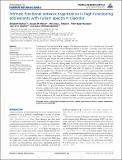Intrinsic functional network organization in high-functioning adolescents with autism spectrum disorder
Author(s)
Redcay, Elizabeth; Moran, Joseph M.; Tager-Flusberg, Helen; Gabrieli, John D. E.; Mavros, Penelope L.; Whitfield-Gabrieli, Susan; ... Show more Show less
DownloadRedcay-2013-Intrinsic functional.pdf (2.684Mb)
PUBLISHER_POLICY
Publisher Policy
Article is made available in accordance with the publisher's policy and may be subject to US copyright law. Please refer to the publisher's site for terms of use.
Terms of use
Metadata
Show full item recordAbstract
Converging theories and data suggest that atypical patterns of functional and structural connectivity are a hallmark neurobiological feature of autism. However, empirical studies of functional connectivity, or, the correlation of MRI signal between brain regions, have largely been conducted during task performance and/or focused on group differences within one network [e.g., the default mode network (DMN)]. This narrow focus on task-based connectivity and single network analyses precludes investigation of whole-brain intrinsic network organization in autism. To assess whole-brain network properties in adolescents with autism, we collected resting-state functional connectivity MRI (rs-fcMRI) data from neurotypical (NT) adolescents and adolescents with autism spectrum disorder (ASD). We used graph theory metrics on rs-fcMRI data with 34 regions of interest (i.e., nodes) that encompass four different functionally defined networks: cingulo-opercular, cerebellar, fronto-parietal, and DMN (Fair et al., 2009). Contrary to our hypotheses, network analyses revealed minimal differences between groups with one exception. Betweenness centrality, which indicates the degree to which a seed (or node) functions as a hub within and between networks, was greater for participants with autism for the right lateral parietal (RLatP) region of the DMN. Follow-up seed-based analyses demonstrated greater functional connectivity in ASD than NT groups between the RLatP seed and another region of the DMN, the anterior medial prefrontal cortex. Greater connectivity between these regions was related to lower ADOS (Autism Diagnostic Observation Schedule) scores (i.e., lower impairment) in autism. These findings do not support current theories of underconnectivity in autism, but, rather, underscore the need for future studies to systematically examine factors that can influence patterns of intrinsic connectivity such as autism severity, age, and head motion.
Date issued
2013-09Department
Massachusetts Institute of Technology. Department of Brain and Cognitive Sciences; McGovern Institute for Brain Research at MIT; Simons Center for the Social Brain (Massachusetts Institute of Technology)Journal
Frontiers in Human Neuroscience
Publisher
Frontiers Research Foundation
Citation
Redcay, Elizabeth, Joseph M. Moran, Penelope L. Mavros, Helen Tager-Flusberg, John D. E. Gabrieli, and Susan Whitfield-Gabrieli. “Intrinsic functional network organization in high-functioning adolescents with autism spectrum disorder.” Frontiers in Human Neuroscience 7 (2013).
Version: Final published version
ISSN
1662-5161